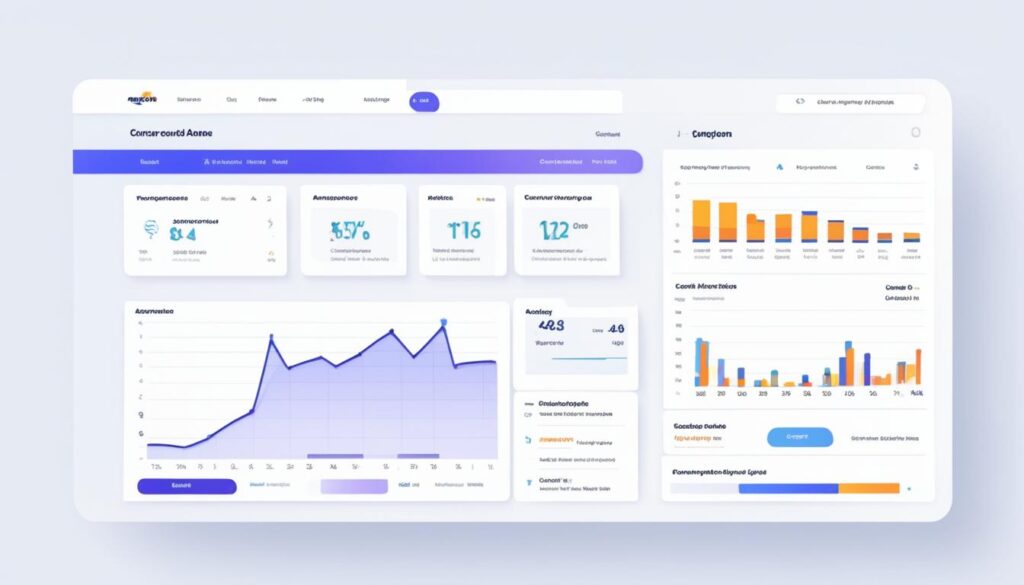Maximize Sales with Amazon PPC Optimization
As an online store owner, you’re likely always looking for ways to increase sales and visibility. One effective way to achieve this is through Amazon PPC optimization. By managing your Amazon advertising campaigns effectively, you can boost visibility and drive sales.
- Understanding the different types of Amazon ads and how to develop a winning PPC strategy.
- Identifying the most relevant keywords for your products and optimizing them for your sponsored ads.
- Creating compelling sponsored ads that resonate with your target audience.
- Optimizing bids and budgets to ensure the best ROI for your campaigns.
- Monitoring, analyzing, and making data-driven decisions to continually improve performance.
Understanding Amazon PPC
Amazon PPC is a powerful tool that can help you drive traffic and boost sales for your online store. But before jumping right into optimizing your campaigns, it’s important to have a clear understanding of how Amazon PPC works.
The Different Types of Amazon Advertising Campaigns
Amazon offers several types of advertising campaigns, including Sponsored Products, Sponsored Brands, and Sponsored Display. Sponsored Products are ads that appear in search results and product detail pages. Sponsored Brands are ads that feature your brand logo, a custom headline, and multiple products. Sponsored Display ads are shown on and off Amazon, targeting shoppers who have viewed similar products.
Developing a Winning Amazon PPC Strategy
To develop a winning Amazon PPC strategy, you need to understand your target audience, perform keyword research, and set realistic goals for your campaigns. Determine your target audience by analyzing customer demographics and identifying their needs and preferences. Use keyword research tools to identify the most relevant keywords for your products.
Managing Your PPC Campaigns Effectively
Effective PPC management involves continuously monitoring your campaigns, adjusting your bids and budgets, and optimizing your ads for maximum performance. Use Amazon’s advertising console to view campaign metrics, such as click-through rates (CTR) and conversion rates. Adjust your bids and budgets regularly to ensure that you are getting the best return on investment (ROI).
“Effective PPC management involves continuously monitoring your campaigns, adjusting your bids and budgets, and optimizing your ads for maximum performance.”
Best Practices for Amazon PPC Management
Effective Amazon PPC management involves more than just setting up campaigns and running ads. To get the most out of your campaigns, use A/B testing to identify the most effective ad formats and targeting options. Use analytics tools to measure the success of your campaigns and make data-driven decisions. Finally, stay up-to-date with the latest industry trends and adjust to changes in the market to stay ahead of your competition.
Keyword Optimization for Amazon PPC
When it comes to Amazon PPC advertising, keyword optimization is a crucial element that can make or break the success of your campaigns. By carefully selecting and targeting relevant keywords, you can drive more targeted traffic to your Amazon product listings and boost your chances of making sales.
Here are some tips to help you optimize your keywords for Amazon PPC:
Identify Relevant Keywords
The first step in optimizing your keywords is to identify the most relevant terms that your customers are likely searching for. Put yourself in the shoes of your target audience and think about what terms they might use to find your products. Conduct thorough keyword research using tools like Google Ads Keyword Planner or Sonar to help you discover new keyword ideas and gauge search volumes.
Use Keywords in Your Ads
Once you have identified relevant keywords, it’s important to incorporate them into your Amazon sponsored ads. Use your keywords in your ad headlines, descriptions, and product listings to ensure that your ads are as relevant as possible to the user’s search query. This will increase your ad’s click-through rate (CTR) and improve your ad’s Quality Score, resulting in better ad visibility and a lower cost per click (CPC).
Explore PPC Tools for Keyword Optimization
There are several PPC tools available that can help you optimize your keywords and drive targeted traffic to your Amazon listings. Tools like PPC Scope and SellerApp can help you discover new keyword opportunities, analyze your competitors’ keywords, and track your keyword performance over time. These tools can save you time and effort in managing your Amazon PPC campaigns and help you make data-driven decisions.
“Optimizing your Amazon PPC keywords is essential to drive more targeted traffic to your listings and maximize your ROI. By using relevant, targeted keywords and leveraging PPC tools for optimization, you can gain a competitive edge and boost your sales on Amazon.”
Creating Compelling Sponsored Product Ads
Amazon sponsored products and ads are a powerful way to draw attention to your listings and generate sales. To create a compelling ad, start by considering your target audience and what will resonate with them. Use eye-catching product images and compelling ad copy to highlight the benefits of your products. Emphasize unique selling points that differentiate your products from those of your competitors.
“The best ads are visually appealing and make it crystal clear why the shopper should buy your product.” -Single Grain
To further increase your chances of success, include a clear call-to-action button to encourage shoppers to take action. Use action-oriented language to prompt them to buy or learn more about your products. Ensure that your ads comply with Amazon’s policies and advertising guidelines.
Remember to regularly monitor the performance of your ads and make adjustments as needed based on data-driven insights. Keep testing and iterating your ad strategies to continuously improve your ad performance.
Best Practices for Creating Sponsored Product Ads
| Best Practices | Why It Matters |
|---|---|
| Include High-Quality Product Images | Eye-catching product images can attract shoppers and communicate the unique features and benefits of your products. |
| Write Compelling Ad Copy | Well-written ad copy can inspire shoppers to take action and drive conversions. |
| Add Clear Call-to-Action Buttons | Encourage shoppers to buy or learn more about your products by including clear, action-oriented call-to-action buttons. |
| Differentiate Your Products | Highlight what makes your products unique and stand out from competing products on Amazon. |
| Comply with Amazon Policies and Advertising Guidelines | Ensure that your ads follow Amazon’s policies and guidelines to prevent account suspension. |
Optimizing Bids and Budgets
Effective Amazon PPC management involves optimizing bids and budgets in order to achieve the best return on investment (ROI) for your advertising campaigns. This requires strategic planning and continuous monitoring to ensure that your budget is being used efficiently and effectively.
One way to optimize your bids is by using Amazon’s Bid+ feature, which automatically increases your bid by up to 50% for keywords likely to lead to a sale. However, it’s important to set a limit on your Bid+ usage to prevent overspending.
Another strategy is to adjust your bids for different ad placements, such as top of search (first page) or product pages, based on their potential to generate sales. This can help maximize visibility and sales for your most profitable keywords.
Avoiding Keyword Cannibalization
One common mistake in Amazon PPC management is keyword cannibalization, where multiple ads compete for the same keyword and increase your advertising costs without necessarily leading to more sales. This can be avoided by creating negative keywords, which prevent ads from being triggered by irrelevant search terms.
Managing Your Budget
Effectively managing your budget is crucial in Amazon PPC optimization. Set a daily budget that aligns with your campaign goals and monitor your spending closely to ensure that you’re not overspending. If you’re running multiple campaigns, consider using Amazon’s budget management tool to allocate your daily budget across campaigns and keywords effectively.

“By optimizing your bids and budgets, you can ensure that your Amazon PPC campaigns are driving the maximum amount of sales for your store.”
Monitoring and Analyzing Campaign Performance
Running a PPC campaign on Amazon requires consistent vigilance to ensure good performance. To maximize the output of your Amazon advertising campaign and avoid wasting money on less useful advertisements, you must track and analyze the metrics and indicators. The most critical measurements to watch are click-through rate (CTR), conversion rate, and cost of sales (COS).
CTR reveals the percentage of times your product advertisement is clicked compared to the number of times it was displayed. By viewing this metric, you can know the reach of your ad and use the information to improve its visibility in the Amazon marketplace.
Conversion Rate deals with the percentage of users that clicked on your advertisement and ended up buying the product. Therefore, it tells you the ad’s ability to convert users into customers. If your campaign is generating clicks but meager sales, it’s time to rethink your strategy carefully.
Cost of Sales (COS) is another significant metric applied to measure the performance of your Amazon advertising campaign. It calculates the amount you spent on advertising for each sale made. The cost of sale percentage is derived by dividing the advertising cost of a product by its total sale value, providing insights into how much individual ads relate to sales revenue.
By analyzing these metrics, you can identify bottlenecks and areas of weakness in your advertising strategy. Track your PPC campaigns frequently and use the data to make data-driven decisions. To assist in this data analysis endeavor, there are numerous tools and techniques you can use to keep an eye on all crucial metrics for your Amazon advertising campaign and take a well-informed decision.
In the next section, we will explore A/B testing and iterative optimization and how you can use them to refine your Amazon advertising campaign.
A/B Testing and Iterative Optimization
One of the best ways to optimize your Amazon PPC campaigns is through A/B testing. This involves testing different versions of your ads to see which performs better and drives more sales. By conducting iterative optimization, you can continually refine and improve your ads to drive better results.
When conducting A/B testing, it is important to test different elements of your ads, such as headlines, images, and ad placement. By testing one element at a time and measuring the impact on performance, you can identify the most effective combination of elements for your ad.
It’s worth noting that A/B testing requires time and resources, particularly if you have a large number of ads. However, the insights you gain from testing can be invaluable in driving better performance and sales for your Amazon store.
To conduct iterative optimization, make data-driven decisions by analyzing key metrics such as click-through rate (CTR) and conversion rate. Experiment with different ad formats, targeting options, and bid strategies to find the optimal combination for your campaigns. By continually refining and improving your ads, you can stay ahead of the competition and maximize your ROI on Amazon PPC advertising.
Adapting to Market Trends and Competitor Analysis
Amazon PPC optimization and PPC advertising require staying on top of market trends and constantly analyzing your competitors. By adapting to changes in market demands, seasonal trends, and new product launches, you can gain a competitive edge over rival sellers. Conducting regular competitor analysis can provide insights into new keywords, strategies, and customer trends. Here are some key strategies for staying ahead of the curve:
Keep up with Market Changes
One of the best ways to stay ahead of the game is by keeping up with market changes. Keep an eye on market trends, seasonal trends, and new product launches. Ensure that your Amazon advertising campaign stays up-to-date by modifying your product listings, adjusting your targeting and bidding strategy or incorporating new types of campaigns.
Analyze Your Competitors
Conduct thorough competitor analysis to see what your competition is doing and gain an edge over them. By identifying your competitors’ strengths and weaknesses, analyzing their keyword strategies, landing pages, and product listings, you can improve your own advertising campaigns and stand out to your target customers.
| Description | Example | |
|---|---|---|
| Strengths | Identify what your competitors are doing well and replicate their strategies. | Your competitor might have a high ROI on a particular set of keywords. Analyze their campaign structure and try to implement the best practices into your own campaign. |
| Weaknesses | Pinpoint the shortcomings of your competitors and find ways to fill the gap. | If your competitor has limited product offerings, you have an opportunity to target customers who are looking for more variety in the products you are both selling. |
| Keywords | Analyze the keywords your competitors are targetting and find opportunities to stand out. | If your competitor is bid aggressively on specific words but neglecting some long-tail keywords, it presents you with the opportunity to dominate the market for those particular keywords. |
| Landing Pages | Understand your competitors’ product landing pages and find ways to improve yours. | Review your competitors’ product landing pages, look for areas they are struggling and use that to optimize your own landing pages. |
| Listings | Analyze your competitor’s product listings and refine your own. | Look for patterns in the competitor’s product listings to identify areas you can improve in your own and optimize them |
By implementing these strategies, you can stay ahead of market trends, improve your Amazon PPC campaigns. Don’t forget that every marketplace Amazon covers should be treated differently and it is important to tailor your strategy to each specific marketplace.
Amazon PPC Optimization Wrap Up
Optimizing your Amazon PPC campaigns is crucial to maximize sales and visibility for your online store. By understanding the fundamentals of Amazon PPC, optimizing keywords, creating compelling ads, and continuously monitoring and adapting your campaigns, you can unlock the full potential of your Amazon store.
Implement these expert tips and strategies to boost your visibility, drive targeted traffic, and ultimately increase sales on Amazon. Remember to keep an eye on market trends, conduct competitor analysis, and continually test and optimize your campaigns to stay ahead of the curve.
With these tools and techniques in your arsenal, you’ll be well-equipped to maximize your results and achieve your sales goals on Amazon. Happy selling!
Learn More About Amazon SEO
FAQ
Why is Amazon PPC optimization important for maximizing sales?
Amazon PPC optimization is crucial for maximizing sales because it helps increase visibility and drive targeted traffic to your listings. By optimizing your PPC campaigns, you can ensure that your products appear in front of potential customers who are actively searching for similar items, increasing the chances of conversions and sales.
What is Amazon PPC?
Amazon PPC (Pay-Per-Click) is an advertising program offered by Amazon that allows sellers to promote their products by bidding on keywords relevant to their listings. The ads appear in search results and product detail pages, and sellers only pay when someone clicks on their ads.
How can I develop a winning Amazon PPC strategy?
To develop a winning Amazon PPC strategy, start by setting clear goals for your campaigns and doing thorough keyword research. Determine your target audience, set competitive bids, and continuously monitor and optimize your campaigns based on performance data. Experiment with different ad formats and targeting options to find what works best for your products and target audience.
What are some best practices for managing Amazon PPC campaigns effectively?
Some best practices for managing Amazon PPC campaigns effectively include regularly checking and adjusting bids, monitoring keyword performance, testing different ad variations, optimizing product listings for relevancy, and tracking campaign performance through metrics like click-through rate (CTR) and cost of sales (COS).
How can I optimize keywords for my Amazon PPC campaigns?
To optimize keywords for your Amazon PPC campaigns, conduct thorough keyword research to identify relevant and high-converting keywords. Use these keywords strategically in your ad copy, product titles, and bullet points. Consider utilizing Amazon PPC tools to identify new keyword opportunities and refine your keyword strategy based on real-time data.
How can I create compelling sponsored product ads?
To create compelling sponsored product ads, focus on creating eye-catching product images that highlight the unique selling points of your products. Write concise and persuasive ad copy that clearly communicates the benefits of your products. Include a compelling call-to-action button and ensure that your ads are relevant to the keywords you are bidding on.
How can I optimize bids and budgets for my Amazon PPC campaigns?
To optimize bids and budgets, consider setting competitive bids based on keyword performance and the estimated value of a conversion. Monitor the performance of your campaigns and adjust bids as needed to maximize return on investment (ROI). Analyze the data to identify areas where budget allocation can be optimized to drive better performance.
How can I monitor and analyze the performance of my Amazon PPC campaigns?
To monitor and analyze the performance of your Amazon PPC campaigns, track key metrics such as click-through rate (CTR), conversion rate, and cost of sales (COS). Utilize Amazon’s advertising reports and consider using third-party tools to get more detailed insights into your campaign performance. Analyze the data regularly to make data-driven decisions and optimize your campaigns.
What is A/B testing and how can it help optimize Amazon PPC campaigns?
A/B testing involves running two or more variations of an ad and comparing their performance to identify the best-performing version. A/B testing can help optimize Amazon PPC campaigns by testing different elements such as headlines, images, ad copy, and ad placement to determine the most effective combination. By continuously testing and iterating, you can improve your ad performance over time.
How can I adapt to market trends and analyze competitors in my Amazon PPC campaigns?
To adapt to market trends, stay updated with industry news and identify seasonal trends that may impact your products. Continuously analyze your competitors by monitoring their pricing, ad strategies, and product launches. Leverage this information to make strategic decisions in your Amazon PPC campaigns, such as adjusting bids or targeting specific keywords to gain a competitive edge.















